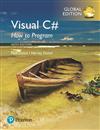| FindBook |
有 5 項符合
VISUAL C# HOW TO PROGRAM 6/E(GE)的圖書 |
 |
VISUAL C# HOW TO PROGRAM 6/E(GE) 作者:DEITEL、DEITEL 出版社:PRENTICE HALL 出版日期:2017-07-04 語言:繁體書 |
| 圖書選購 |
| 型式 | 價格 | 供應商 | 所屬目錄 | 二手書 |
$ 310 |
二手中文書 |
$ 1615 |
原文書 |
$ 1666 |
中文書 |
$ 1666 |
高等教育 |
$ 1700 |
資訊 |
|---|
| 圖書館借閱 |
| 國家圖書館 | 全國圖書書目資訊網 | 國立公共資訊圖書館 | 電子書服務平台 | MetaCat 跨館整合查詢 |
| 臺北市立圖書館 | 新北市立圖書館 | 基隆市公共圖書館 | 桃園市立圖書館 | 新竹縣公共圖書館 |
| 苗栗縣立圖書館 | 臺中市立圖書館 | 彰化縣公共圖書館 | 南投縣文化局 | 雲林縣公共圖書館 |
| 嘉義縣圖書館 | 臺南市立圖書館 | 高雄市立圖書館 | 屏東縣公共圖書館 | 宜蘭縣公共圖書館 |
| 花蓮縣文化局 | 臺東縣文化處 |
|
|
新版特色:
● Integrated coverage of new C# 6 functionality.
● C# 6 new language features appear throughout the book and each occurrence is marked with a “6” margin icon
● All material is updated for use with Visual Studio 2015.
Hundreds of exercises updated for student practice skills
圖書特色與優點:
Signature “Live Code™ Approach” — Language features are presented in the context of a wide variety of complete working programs.
● Features thousands of lines of code in hundreds of complete working programs.
● A broad range of example programs selected from computer science, business, simulation, game playing, graphics, multimedia and many other areas.
● Enables students to confirm that programs run as expected.
● Students can also download the code from the book's Companion Website www.pearsonglobaleditions.com/deitel.
Object-Oriented Programming
● Outstanding, consistent, and applied pedagogy. Icons throughout identify Software Engineering Observations; Good Programming Practices; Common Programming Errors; Portability Tips; Performance Tips; Testing and Debugging Tips; and Look-and-Feel Observations.
● Early-objects approach. The book introduces the basic concepts and terminology of object technology in Chapter 1. In Chapter 2, students will visually manipulate graphical user interface objects, such as labels and images. In Chapter 3, Introduction to C# App Programming, students will write Visual C# program code that manipulates preexisting objects. They will develop their first customized classes and objects in Chapter 4. Our early objects presentation continues in Chapters 5–9 with a variety of straightforward case studies. Chapters 10–12 take a deeper look at classes and objects.
● Rich coverage of programming fundamentals. Chapters 5 and 6 present a friendly treatment of control statements and problem solving.
● A clear, example-driven presentation of classes, objects, inheritance, polymorphism and interfaces.
● Optional case study: Using the UML to develop an object-oriented design and Visual C# implementation of an Automated Teller Machine (ATM). The UML™ (Unified Modeling Language™) is the industry-standard graphical language for modeling object-oriented systems. We introduce the UML in the early chapters. Online Chapters 34 and 35 include an optional case study on object-oriented design using the UML. We design and implement the software for a simple automated teller machine. We analyze a typical requirements document that specifies the system to be built. We determine the classes needed to implement that system, theattributes the classes need to have, the behaviors the classes need to exhibit and we specify how the classes must interact with one another to meet the system requirements. From the design we produce a complete working Visual C# implementation. Students often report a “light bulb moment”–the case study helps them “tie it all together” and truly understand object orientation.
● Four programming paradigms. We discuss structured programming, object-oriented programming, generic programming and functional programming (new in this edition).
Interesting, Entertaining and Challenging Exercises
● Extensive self-review exercises and answers are included for self-study.
● Each chapter concludes with a substantial set of exercises, including simple recall of important terminology and concepts, identifying the errors in code samples, writing individual program statements, writing methods to perform specific tasks, writing C# classes, writing complete programs and implementing major projects. The Making a Difference exercises encourage you to use computers and the Internet to research and work on significant social problems–we hope you’ll approach these exercises with your own values, politics and beliefs.
Illustrations and Figures
● Abundant tables, line drawings, UML diagrams, programs and program outputs are included.
The book’s modular organization helps instructors plan their syllabi.
Other Features
● Use as appropriate with Windows 7, 8 or 10.
● A clear, example-driven presentation of classes, objects, inheritance, polymorphism and interfaces.
● Early introduction to LINQ and generic collections.
● PLINQ (Parallel LINQ) for multicore performance.
● Asynchronous Programming with async and await.
● Functional programming with lambdas and delegates.
● Immutability, files, database with LINQ to Entities.
● Visual C# debugging, integrated exception handling.
● Extensive treatment of Windows Forms GUI.
● Online coverage of Universal Windows Platform (UWP) GUI for desktop and mobile apps.
● The printed book contains the core content (Chapters 1–23) for introductory course sequences.
● Additional online content for more advanced courses: ASP.NET web app development; XML and LINQ to XML; Building a Microsoft Azure™ Cloud Computing App; Web Services and ATM OOD case study.
An informative, engaging, challenging and entertaining introduction to Visual C#
Created by world-renowned programming instructors Paul and Harvey Deitel, Visual C# How to Program, Sixth Edition introduces students to the world of desktop, mobile and web app development with Microsoft?Visual C#?programming language. Students will use the .NET platform and the Visual Studio?Integrated Development Environment to write, test, ...
Ch2: Introduction to Visual Studio and Visual Programming
Ch3: Introduction to C# App Programming
Ch4: Introduction to Classes, Objects, Methods and strings
Ch5: Algorithm Development and Control Statements: Part 1
Ch6: Control Statements: Part 2
Ch7: Methods: A Deeper Look
Ch8: Arrays; Introduction to Exception Handling
Ch9: Introduction to LINQ and the List Collection
Ch10: Classes and Objects: A Deeper Look
Ch11: Object-Ori...
- 作者: DEITEL、DEITEL
- 出版社: PRENTICE HALL 出版日期:2017-07-04 ISBN/ISSN:9781292153469
- 語言:繁體中文 裝訂方式:平裝 頁數:1056頁 開數:20 K
- 類別: 中文書> 電腦> 程式語言
|









